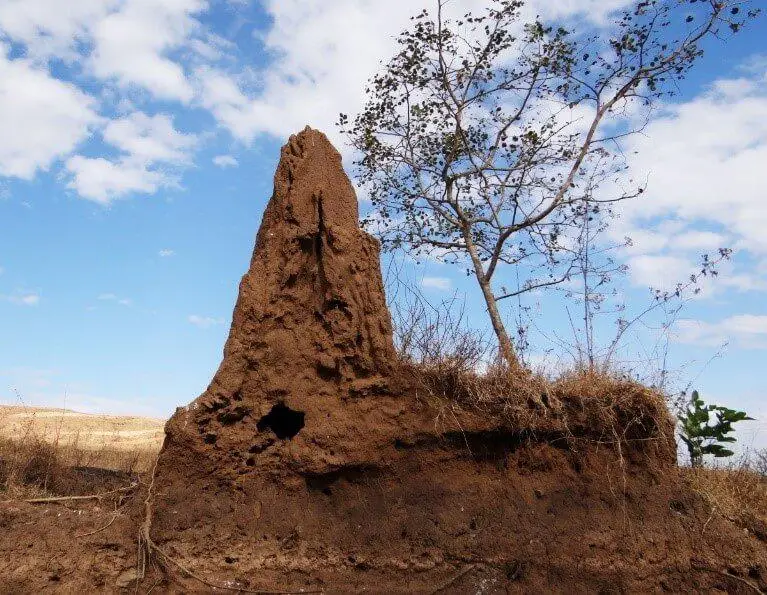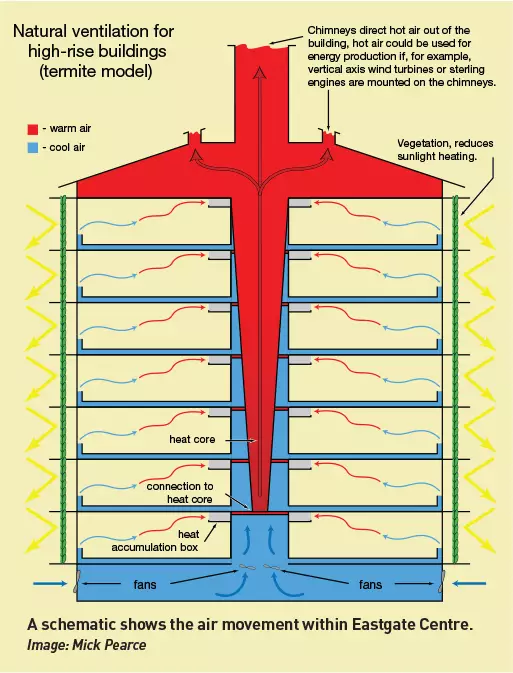Biomimetic architecture and its role in sustainability
Posted: February 13 2021

Aneesa, Environmental Sciences BSc
Defined as, ‘the emulation of the models, systems and elements of nature for the service of solving complex human problems,’ (The Essentials of Biomimicry | Katerva, 2021) could biomimicry be a solution to the promotion of sustainability in construction? Can we mimic the behaviour of animals and insects in the ways they construct their self-built homes, to create buildings that are more in tune with nature and sustainability principles?
This is a possibility worth exploring. Architects around the world have begun designing buildings that mimic the nature of structures created by animals in the environment. Following the example of termites that regulate the temperature of the mud mounds they live in by piercing holes in their mud mounds so that the fungus they feed on can thrive, civil engineers have designed buildings with a similar temperature regulation system.

Figure 1 A termite mound
How does this temperature regulation system work? The holes that the termites pierce in their mud mound act as chimneys where the air passes though, and may vary in size. During the day, warm air passes through the thinner holes located on the sides of the mound, which raises the temperature in the mound. In the middle of the mound, there is a bigger vertical hole, known as the central chimney that remains relatively cooler than the air entering the sides of the mound, acting as a temperature regulator and preventing the mound from heating up too much. At night, the temperature regulation reverses, with cooler air entering through the smaller chimneys cooling the central chimney and entire mound (ASME, 2021). This natural air circulation system factors in changes in the temperature during day and night time, effectively regulating the temperature of the termite mound.
In buildings, the system that termites create within their mounds could be emulated in the design and installation of ventilation systems. The Eastgate centre in Zimbabwe is an example structure where this natural ventilation system is installed. As illustrated in Figure 2, cool air is drawn in at the first floor and pushed up vertically through the supply sections of ducts located at the spine of the building, through to the top of the building (Fehrenbacher, J., 2020). Warm air from each floor heats up the air in the central chimney, which is directed upwards via the flow of the cooler air injected in each floor and through the side of the central chimney, mimicking the processes that occur in the termite mound.

Figure 2 The air movement in the nature inspired ventilation system installed in high rise buildings (Image: Mick Pearce)
In comparison to a conventional building of the same size, the Eastgate Centre uses 10% less energy and its owners have saved $3.5 million, by not having to install an air-conditioning system, in addition to the operational energy savings of having an air conditioning system installed, and the carbon footprint associated with it. Additionally, due to these savings, rent for tenants within the building is 20% lower than those in surrounding buildings.
Another example that lends itself to nature-inspired building design is the sea sponge, Venus’ flower basket (Euplectella aspergillum). Sea sponges are particularly special because they create a filtration system within their structure. They have a cylindrical lattice-like structure made from a mesh of silica spicules, which delicately filter the water and retain the organic particles they feed on. Small spicules (siliceous structures to support the body of the sponge) at the end of the mesh basket trap natural light and allow the separation of organic matter from any debris in the water and the organic matter then travels to the top of the top of the basket.
The Gherkin, one of London’s most famous sky scrapers, adopts an architecturally similar cylindrical structure to that of the sea sponge. Instead of filtering water, the structure was designed to filter the air and create a mixed-mode ventilation system in cooperation with the endoskeleton of the building. The exoskeleton of the Gherkin acts as the silica-based mesh (with windows instead of spicules) that slowly filters the warm air that enters through the structure mesh. The curvature of the building mimics the mechanism of the spicules, giving impetus to the air to travel upwards the building, thereby regulating the temperature and reducing air conditioning usage by 50% (Nkandu and Alibaba, 2021).

Figure 3 (a) Image of the sea sponge Venus’ flower basket (Euplectella aspergillum); (b) the famous Gherkin building located in London, on the right is an. It is clear to see just by looking at both picture there are structural similarities between them both.
There’s an irony behind the fact humans tend to strive for constant intellectual development and the need to detach ourselves from behaviours that are defined as animalistic and primitive. And yet, nature, that provides us with all the natural resources that we need to develop and nurture our modern lifestyles, has still so much to offer and help us become more in tune with our natural environment. Nature itself can help us live in a way that is more sustainable and less destructive. Biomimicry is a huge step in the right direction in terms of fulfilling the aims of the sustainable agenda. Technological advancements have allowed humans to develop research methods that can be utilised to observe the natural environment and its inhabitants and guide us to implement the observed behaviours in construction and design. One day we could live in a world where we have balanced the imbalance we are causing today, and which destructs our natural environment.
*****
London skyline banner photo: pexels.com
About Aneesa
Aneesa is a third year Environmental Sciences Student, at Brunel University London. Her main passion lies within promoting sustainable development globally. She has worked on and participated in competitions in collaboration with the UNCHR and Mayor of London that aim to promote sustainable development in the form of the creation of sustainable products. Additionally, she is an advocate for acknowledging the climate change induced issues in the global south and has worked with charities to deliver sustainable products to developing areas in that region. She hopes that through effective governance and collaboration the world will begin to live more sustainably and less destructively.